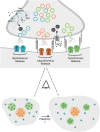Nano-Organization at the Synapse: Segregation of Distinct Forms of Neurotransmission
- PMID: 35002671
- PMCID: PMC8727373
- DOI: 10.3389/fnsyn.2021.796498
Nano-Organization at the Synapse: Segregation of Distinct Forms of Neurotransmission
Abstract
Synapses maintain synchronous, asynchronous, and spontaneous modes of neurotransmission through distinct molecular and biochemical pathways. Traditionally a single synapse was assumed to have a homogeneous organization of molecular components both at the active zone and post-synaptically. However, recent advancements in experimental tools and the further elucidation of the physiological significance of distinct forms of release have challenged this notion. In comparison to rapid evoked release, the physiological significance of both spontaneous and asynchronous neurotransmission has only recently been considered in parallel with synaptic structural organization. Active zone nanostructure aligns with postsynaptic nanostructure creating a precise trans-synaptic alignment of release sites and receptors shaping synaptic efficacy, determining neurotransmission reliability, and tuning plasticity. This review will discuss how studies delineating synaptic nanostructure create a picture of a molecularly heterogeneous active zone tuned to distinct forms of release that may dictate diverse synaptic functional outputs.
Keywords: asynchronous neurotransmission; nanocolumn; spontaneous neurotransmission; synaptic transmission and plasticity; synchronous neurotransmission.
Copyright © 2021 Guzikowski and Kavalali.
Conflict of interest statement
The authors declare that the research was conducted in the absence of any commercial or financial relationships that could be construed as a potential conflict of interest.
Figures


Similar articles
-
Distinct Calcium Sources Support Multiple Modes of Synaptic Release from Cranial Sensory Afferents.J Neurosci. 2016 Aug 24;36(34):8957-66. doi: 10.1523/JNEUROSCI.1028-16.2016. J Neurosci. 2016. PMID: 27559176 Free PMC article.
-
Vesicle dynamics: how synaptic proteins regulate different modes of neurotransmission.J Neurochem. 2013 Jul;126(2):146-54. doi: 10.1111/jnc.12245. Epub 2013 Apr 23. J Neurochem. 2013. PMID: 23517499 Review.
-
Synaptotagmin-7-Mediated Asynchronous Release Boosts High-Fidelity Synchronous Transmission at a Central Synapse.Neuron. 2017 May 17;94(4):826-839.e3. doi: 10.1016/j.neuron.2017.04.020. Neuron. 2017. PMID: 28521135
-
Loss of Doc2-Dependent Spontaneous Neurotransmission Augments Glutamatergic Synaptic Strength.J Neurosci. 2017 Jun 28;37(26):6224-6230. doi: 10.1523/JNEUROSCI.0418-17.2017. Epub 2017 May 24. J Neurosci. 2017. PMID: 28539418 Free PMC article.
-
Partitioning the synaptic landscape: distinct microdomains for spontaneous and spike-triggered neurotransmission.Sci Signal. 2009 Apr 7;2(65):pe19. doi: 10.1126/scisignal.265pe19. Sci Signal. 2009. PMID: 19351951 Review.
Cited by
-
Serine-129 phosphorylation of α-synuclein is an activity-dependent trigger for physiologic protein-protein interactions and synaptic function.Neuron. 2023 Dec 20;111(24):4006-4023.e10. doi: 10.1016/j.neuron.2023.11.020. Neuron. 2023. PMID: 38128479 Free PMC article.
-
Genetic disorders of neurotransmitter release machinery.Front Synaptic Neurosci. 2023 Mar 31;15:1148957. doi: 10.3389/fnsyn.2023.1148957. eCollection 2023. Front Synaptic Neurosci. 2023. PMID: 37066095 Free PMC article. Review.
-
Opposing retrograde and astrocyte-dependent endocannabinoid signaling mechanisms regulate lateral habenula synaptic transmission.Cell Rep. 2023 Mar 28;42(3):112159. doi: 10.1016/j.celrep.2023.112159. Epub 2023 Feb 26. Cell Rep. 2023. PMID: 36842084 Free PMC article.
-
SGIP1 in axons prevents internalization of desensitized CB1R and modifies its function.Front Neurosci. 2023 Jul 20;17:1213094. doi: 10.3389/fnins.2023.1213094. eCollection 2023. Front Neurosci. 2023. PMID: 37547151 Free PMC article. Review.
-
Laser microsurgery for presynaptic interrogation.Nat Protoc. 2025 Aug;20(8):2345-2367. doi: 10.1038/s41596-024-01125-5. Epub 2025 Feb 7. Nat Protoc. 2025. PMID: 39920306 Review.
References
Publication types
LinkOut - more resources
Full Text Sources

